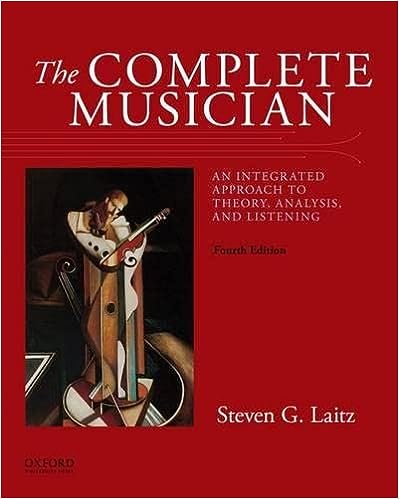Description
The Complete Musician: An Integrated Approach to Theory, Analysis, and Listening 4th Edition, ISBN-13: 978-0199347094
[PDF eBook eTextbook]
- Publisher: Oxford University Press; 4th edition (November 20, 2015)
- Language: English
- 960 pages
- ISBN-10: 0199347093
- ISBN-13: 978-0199347094
Beginning with music fundamentals, The Complete Musician covers all the topics necessary for a thorough understanding of undergraduate music theory by focusing on music in context. Rather than rote learning of concepts and memorizing terms, The Complete Musician emphasizes how theory informs the work of performers. Composers respond not only to their instincts, experiences, and training in every work they write; they also follow certain ideals and models when appropriate, and modify them to fit their own personal vision. Theory is not a “theoretical” activity; it is a living one that responds to how music is composed and performed. Understanding how theory intersects with composition and performance is key to seeing its relevance to students’ wider musical lives. The Complete Musician makes this connection.
Table of Contents:
CONTENTS
PREFACE
PART 1 THE FOUNDATIONS OF TONAL MUSIC
CHAPTER 1A: Musical Space
Chapter Overview
Tonality in Context: Bach’s Violin Partita no. 3, Prelude
Specifics of the Pitch Realm
Terms and Concepts
Chapter Review
CHAPTER 1B: Musical Time: Pulse, Rhythm, and Meter
Chapter Overview
Rhythm and Durational Symbols
Meter
More Rhythmic Procedures
Accent in Music
Metrical Disturbance
Terms and Concepts
Chapter Review
CHAPTER 2 Harnessing Space and Time: Introduction to Melody and Two-Voice Counterpoint
Chapter Overview
Melody: Characteristics and Writing
Controlling Consonance and Dissonance: Introduction to Two-Voice Counterpoint
Counterpoint in History
Two-Voice Counterpoint as Musical Foundation
Terms and Concepts
Chapter Review
CHAPTER 3 Musical Density: Triads, Seventh Chords, and Texture
Chapter Overview
Adding Voices: Triads and Seventh Chords
Seventh Chords
Musical Texture
Terms and Concepts
Chapter Review
Summary of Part 1
PART 2 MERGING MELODY AND HARMONY
CHAPTER 4 When Harmony, Melody, and Rhythm Converge
Chapter Overview
Tonal Hierarchy in Music
Embellishing Tones
The Importance of Context in Analysis
Analytical Interlude
Melodic Fluency
The Arch and Nested Lines
Melody as Harmony
Terms and Concepts
Chapter Review
CHAPTER 5 Tonic and Dominant as Tonal Pillars and Introduction to Voice Leading
Chapter Overview
Characteristics and Effect of V and I
The Cadence
Introduction to Voice Leading
Summary of Voice-Leading Rules and Guidelines
Terms and Concepts
Chapter Review
CHAPTER 6 The Impact of Melody, Rhythm, and Meter on Harmony; Introduction to V7; and Harmonizing Fl
Chapter Overview
The Interaction of Harmony, Melody, Meter, and Rhythm: Embellishment and Reduction
The Dominant Seventh and Chordal Dissonance
V[sup(7)] and I Chords
Harmonizing Folk-Type Melodies
Summary
Terms and Concepts
Chapter Review
CHAPTER 7 Contrapuntal Expansions of Tonic and Dominant: Six- Three Chords
Chapter Overview
Chordal Leaps in the Bass: I[sup(6)] and V[sup(6)]
Neighbor Tones in the Bass (V[sup(6)])
Second-Level Analysis
Passing Tones in the Bass: vii°[sup(6)]
Tonic Expansion the Long Way: Descending a Sixth from 1 to 3 through V or IV[sup(6)]
Dominant Expansion with Passing Tones: IV[sup(6)]
Combining First-Inversion Chords
Summary
Terms and Concepts
Chapter Review
CHAPTER 8 More Contrapuntal Expansions: Inversions of VTonic Expansion the Long Way: Descending a Si
Chapter Overview
V[sup(7)] and Its Inversions
Leading-Tone Seventh Chords: vii°[sup(7)] and viiø[sup(7)]
Compositional Impact of Contrapuntal Chords
Summary of Contrapuntal Expansions
Reduction and Elaboration: Compositional and Performance Implications
Terms and Concepts
Chapter Review
Summary of Part 2
PART 3 A NEW HARMONIC FUNCTION, THE PHRASE MODEL, AND ADDITIONAL MELODIC AND HARMONIC EMBELLISHMENTS
CHAPTER 9 The Pre-Dominant Function and the Phrase Model
Chapter Overview
The Pre-Dominant Function
Introduction to the Phrase Model
Terms and Concepts
Chapter Review
CHAPTER 10 Accented and Chromatic Embellishing Tones
Chapter Overview
Unaccented Tones of Figuration
Accented Tones of Figuration
Specifics of Unaccented and Accented Tones of Figuration
Accented Embellishing Tones
The Accented Passing Tone (APT)
The Chromatic Passing Tone (CPT)
The Accented Neighbor Tone (AN)
The Chromatic Neighbor Tone (CN)
The Appoggiatura (APP)
The Suspension (S)
The Anticipation (ANT)
The Pedal (PED)
Summary of the Most Common Embellishing Tones
Terms and Concepts
Chapter Review
CHAPTER 11 Six-Four Chords, Revisiting the Subdominant, and Summary of Contrapuntal Expansions
Chapter Overview
Unaccented Six-Four Chords
Accented Six-Four Chords in Cadences
Summary of Harmonic Paradigms
Harmonizing Florid Melodies
Terms and Concepts
Chapter Review
CHAPTER 12 The Pre-Dominant Refines the Phrase Model
Chapter Overview
Nondominant Seventh Chords: IV[sup(7)] (IV6/5) and ii[sup(7)] (ii6/5)
Embedding the Phrase Model
Contrapuntal Cadences
Expanding the Pre-Dominant
Subphrases
Terms and Concepts
Chapter Review
Summary of Part 3
PART 4 NEW CHORDS AND NEW FORMS
CHAPTER 13 The Submediant: A New Diatonic Harmony, and Further Extensions of the Phrase Model
Chapter Overview
The Submediant (vi in Major, VI in Minor)
Voice Leading for the Submediant
Contextual Analysis
The Step Descent in the Bass
Terms and Concepts
Chapter Review
CHAPTER 14 The Mediant, the Back-Relating Dominant, and a Synthesis of Diatonic Harmonic Relationshi
Chapter Overview
The Mediant (iii in Major, III in Minor)
More Contextual Analysis: The Back- Relating Dominant
Synthesis: Root- Motion Principles and Their Compositional Impact
Summary
Terms and Concepts
Chapter Review
CHAPTER 15 The Period
Chapter Overview
Form as Process
Aspects of Melody and Harmony in Periods
Representing Form: The Formal Diagram
Sample Analyses of Periods and Some Analytical Guidelines
Composing Periods
Terms and Concepts
Chapter Review
CHAPTER 16 Other Small Musical Structures: Sentences, Double Periods, and Modified Periods
Chapter Overview
The Sentence: An Alternative Musical Structure
The Double Period
Modified Periods
Terms and Concepts
Chapter Review
CHAPTER 17 Harmonic Sequences
Chapter Overview
Components and Types of Sequences
Writing Sequences
Terms and Concepts
Chapter Review
Summary of Part 4
PART 5 FUNCTIONAL CHROMATICISM
CHAPTER 18 Applied Chords
Chapter Overview
Applied Dominant Chords
More-Extensive Tonicizations of Nontonic Harmonies
Applied Leading-Tone Chords
Incorporating Applied Chords Within Phrases
Sequences with Applied Chords
Summary of Diatonic and Applied-Chord Sequences
Terms and Concepts
Chapter Review
CHAPTER 19 Tonicization and Modulation
Chapter Overview
Extended Tonicization
Modulation
Terms and Concepts
Chapter Review
CHAPTER 20 Binary Form and Variations
Chapter Overview
Binary Form
Variation Form
Terms and Concepts
Chapter Review
Answers to Exercise Interlude 20.1
Summary of Part 5
PART 6 EXPRESSIVE CHROMATICISM
CHAPTER 21 Modal Mixture
Chapter Overview
Altered Pre-Dominant Harmonies: ii° and iv
Altered Submediant Harmony: bVI
Altered Tonic Harmony: i
Altered Mediant Harmony: bIII
Voice Leading for Mixture Harmonies
Chromatic Stepwise Bass Descents
Plagal Motions
Modal Mixture, Applied Chords, and Other Chromatic Mediants
Summary of Third Relations
Terms and Concepts
Chapter Review
CHAPTER 22 Expansion of Modal Mixture Harmonies: Chromatic Modulation and the German Lied
Chapter Overview
Chromatic Pivot-Chord Modulations
Unprepared and Common-Tone Chromatic Modulations
Analytical Challenges
Modal Mixture and the German Lied
Terms and Concepts
Chapter Review
CHAPTER 23 The Neapolitan Chord (bII)
Chapter Overview
Characteristics, Effects, and Behavior of the Neapolitan Chord
Writing the Neapolitan Chord
Expanding bII
The Neapolitan Chord in Sequences
The Neapolitan Chord as a Pivot Chord
Terms and Concepts
Chapter Review
CHAPTER 24 The Augmented Sixth Chord
Chapter Overview
Characteristics, Effects, and Behavior of the Augmented Sixth Chord
Types of Augmented Sixth Chords
Writing Augmented Sixth Chords
(b)VI and the Ger6/5 Chord
Augmented Sixth Chords as Part of PD Expansions
The Augmented Sixth Chord and Modulation: Reinforcement
The Augmented Sixth Chord as Pivot in Modulations
Terms and Concepts
Chapter Review
Summary of Part 6
PART 7 LARGE FORMS: TERNARY, RONDO, SONATA
CHAPTER 25 Ternary Form
Chapter Overview
Characteristics
Transitions and Retransitions
Da Capo Form: Compound Ternary Form
Da Capo Aria
Minuet-Trio Form
Ternary Form in the Nineteenth Century
Terms and Concepts
Chapter Review
CHAPTER 26 Rondo
Chapter Overview
Context
The Classical Rondo
Terms and Concepts
Chapter Review
CHAPTER 27 Sonata Form
Chapter Overview
Historical Context and Tonal Background
The Binary Model for Sonata Form
Additional Characteristics and Elements of Sonata Form
Other Tonal Strategies
Sonata-Rondo Form
Analytical Synthesis: Sonatas of Haydn and Mozart
Terms and Concepts
Chapter Review
Summary of Part 7
PART 8 INTRODUCTION TO NINETEENTH-CENTURY HARMONY: THE SHIFT FROM ASYMMETRY TO SYMMETRY
CHAPTER 28 New Harmonic Tendencies
Chapter Overview
Tonal Ambiguity: The Plagal Relation and Reciprocal Process
Tonal Ambiguity: Semitonal Voice Leading
Tonal Clarity Postponed: Off-Tonic Beginning
Double Tonality
Symmetry: The Diminished Seventh Chord and Enharmonic Modulation
A Paradox: “Balanced” Music Based on Asymmetry
Symmetry and Tonal Ambiguity
The Augmented Triad
Altered Dominant Seventh Chords
The Common-Tone Diminished Seventh Chord
Common-Tone Augmented Sixth Chords
Terms and Concepts
Chapter Review
CHAPTER 29 Melodic and Harmonic Symmetry Combine: Chromatic Sequences
Chapter Overview
Distinctions Between Diatonic and Chromatic Sequences
Details of Chromatic Sequences
Chromatic Sequence Types
Other Chromatic Step-Descent Basses
Writing Chromatic Sequences
Chromatic Contrary Motion
A Final Equal Division of the Octave
Sequential Progressions
Nonsequential Progressions and Equal Divisions of the Octave
The Intervallic Cell
Terms and Concepts
Chapter Review
PART 9 TWENTIETH-AND TWENTY-FIRST-CENTURY MUSIC
CHAPTER 30 Vestiges of Common Practice and the Rise of a New Sound World
Chapter Overview
Centricity
Form and Process
Always the Same, but Never in the Same Way: Melodies, Motives, Harmony, and Line
Triadic Extensions
Pitch Classes (PCs) and Collections
Pitch-Class Collections with Six Members #1: Whole- Tone Collection
Pitch-Class Collections with Six Members #2: Hexatonic Collection
Eight-Note Collections: Octatonic
Form
Terms and Concepts
Chapter Review
CHAPTER 31 Noncentric Music: Atonal Concepts and Analytical Methodology
Chapter Overview
A New Sound World
A First Analysis
Pitch and Pitch-Class Space
Equivalence
Integer Notation
PC Sets and Modular Arithmetic
More on Equivalence Classes
Computing and Comparing: P and PC Space
P Sets and PC Sets with Three or More Members
A Systematic Approach
Symmetrical Sets
Terms and Concepts
Chapter Review
CHAPTER 32 New Rhythmic and Metric Possibilities, Ordered PC Relations, and Twelve-Tone Techniques
Chapter Overview
Meter and Rhythm
Twelve-Tone Music
Transforming the Row: Twelve-Tone Operators (TTOs)
Application of Twelve-Tone Rows
Berg, Lyric Suite
Multiple Row Forms
The Twelve-Tone Matrix
Simultaneous Row Forms: Combinatoriality
Schoenberg’s Signature Procedure: Inversional Combinatoriality
Variance Versus Invariance
Summary
Terms and Concepts
Chapter Review
GLOSSARY
CREDITS
INDEX OF TERMS AND CONCEPTS
INDEX OF MUSICAL EX AMPLES AND EXERCISES
Steven G. Laitz is chair of the Music Theory and Analysis department at The Juilliard School and Professor of Music Theory at the Eastman School of Music. He serves as Director of the Gail Boyd de Stwolinski Center for Music Theory Pedagogy at the University of Oklahoma and Executive Editor of Music Theory Pedagogy Online.
What makes us different?
• Instant Download
• Always Competitive Pricing
• 100% Privacy
• FREE Sample Available
• 24-7 LIVE Customer Support






